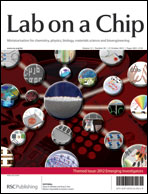On-chip anticancer drug test of regular tumor spheroids formed in microwells by a distributive microchannel network†
Abstract
This paper proposes a new cytotoxicity assay in a microfluidic device with microwells and a distributive microfluidic channel network for the formation of cancer cell spheroids. The assay can generate rapid and uniform cell clusters in microwells and test in situ cytotoxicity of anticancer


 Please wait while we load your content...
Please wait while we load your content...